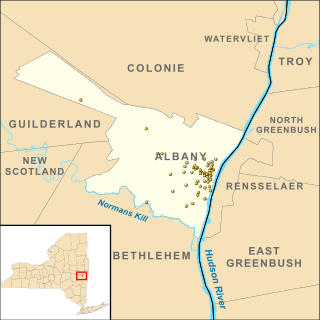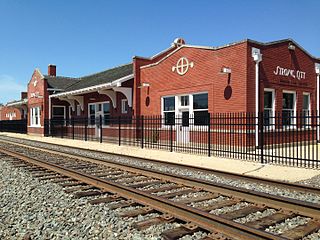
Kingman station is an Amtrak train station located in the historic Kingman Railroad Depot in Kingman, Arizona, United States. Amtrak's Southwest Chief trains stop at the Kingman station once daily in each direction. Kingman is also the transfer point for dedicated, guaranteed Amtrak Thruway Motorcoach service to/from Laughlin, Nevada and Las Vegas, Nevada.

Claremont is a passenger rail and bus station in Claremont, California, United States. It is served by Metrolink's San Bernardino Line which runs from Los Angeles Union Station to San Bernardino-Downtown, with some trains formerly continuing to Riverside on weekends. The Mission Revival-Spanish Colonial Revival style station is listed on the U.S. National Register of Historic Places as Atchison, Topeka and Santa Fe Railroad Station.

The Fullerton Transportation Center is a passenger rail and bus station located in Fullerton, California, United States.

The San Bernardino Santa Fe Depot is a Mission Revival Style passenger rail terminal in San Bernardino, California, United States. It has been the primary station for the city, serving Amtrak today, and the Santa Fe and Union Pacific Railroads in the past. Until the mid-20th century, the Southern Pacific Railroad had a station 3/4 of a mile away. It currently serves one Amtrak and two Metrolink lines. The depot is a historical landmark listed on the National Register of Historic Places as Atchison, Topeka and Santa Fe Railway Passenger and Freight Depot.

The Barstow Harvey House, also known as Harvey House Railroad Depot and Barstow station, is a historic building in Barstow, California. Originally built in 1911 as Casa del Desierto, a Harvey House hotel and Santa Fe Railroad depot, it currently serves as an Amtrak station and government building housing city offices, the Barstow Chamber of Commerce and Visitor Center, and two museums.

The Atchison, Topeka and Santa Fe Passenger and Freight Complex is a nationally recognized historic district located in Fort Madison, Iowa, United States. It was listed on the National Register of Historic Places in 1992. At the time of its nomination it contained three resources, all of which are contributing buildings. The buildings were constructed over a 24-year time period, and reflect the styles that were popular when they were built. The facility currently houses a local history museum, and after renovations a portion of it was converted back to a passenger train depot for Amtrak, which opened on December 15, 2021.

The former Reading Municipal Building is a historic building at 49 Pleasant Street in Reading, Massachusetts. Built in 1885, this two-story brick building was the town's first municipal structure, housing the town offices, jail, and fire station. In 1918 all functions except fire services moved out of the building. It now serves as Reading's Pleasant Street Senior Center. The building was listed on the National Register of Historic Places in 1984.

El Garces Intermodal Transportation Facility is an Amtrak intercity rail station and bus depot in downtown Needles, California. The structure was originally built in 1908 as El Garces, a Harvey House and Atchison, Topeka and Santa Fe Railway (ATSF) station. It is named for Francisco Garcés, a Spanish missionary who surveyed the area in the 1770s. It was added to the National Register of Historic Places in 2002.

There are nine historic districts in Meridian, Mississippi. Each of these districts is listed on the National Register of Historic Places. One district, Meridian Downtown Historic District, is a combination of two older districts, Meridian Urban Center Historic District and Union Station Historic District. Many architectural styles are present in the districts, most from the late 19th century and early 20th century, including Queen Anne, Colonial Revival, Italianate, Art Deco, Late Victorian, and Bungalow.

The Elephant Packing House was built in 1924, in Fullerton, Orange County, Southern California. Valencia oranges were packed here, from the abundant orchards that then dominated the county and gave it its name. William Wolfskill had developed and extensively planted the Valencia orange here in the 19th century. It is one of the last remaining examples of a citrus packing house in Fullerton.

The Honolulu Fire Department (HFD) operates their 44 Fire Stations on the Island of Oahu, and in and around Honolulu. Seven current or former stations are on the National Register of Historic Places, of which five are still in use today as fire stations.

There are 75 properties listed on the National Register of Historic Places in Albany, New York, United States. Six are additionally designated as National Historic Landmarks (NHLs), the most of any city in the state after New York City. Another 14 are historic districts, for which 20 of the listings are also contributing properties. Two properties, both buildings, that had been listed in the past but have since been demolished have been delisted; one building that is also no longer extant remains listed.

The Greenwich Avenue Historic District is a historic district representing the commercial and civic historical development of the downtown area of the town of Greenwich, Connecticut. The district was listed on the National Register of Historic Places on August 31, 1989. Included in the district is the Greenwich Municipal Center Historic District, which was listed on the National Register the year before for the classical revival style municipal buildings in the core of Downtown. Most of the commercial buildings in the district fall into three broad styles, reflecting the period in which they were built: Italianate, Georgian Revival, and Commercial style. The district is linear and runs north–south along the entire length of Greenwich Avenue, the main thoroughfare of Downtown Greenwich, between U.S. Route 1 and the New Haven Line railroad tracks.

The Engine Company 16 Fire Station, also known as the Blue Hills Fire Station, is located at 636 Blue Hills Avenue in Hartford, Connecticut. Built in 1928, it is one of the city's most architecturally distinctive fire stations, a Tudor Revival structure designed by the local firm of Ebbets & Frid. The building was listed on the National Register of Historic Places on March 2, 1989. It continues to serve its original function, housing Engine Company 16 of the Hartford Fire Department.

Great Overland Station, listed on the National Register of Historic Places as Union Pacific Railroad Passenger Depot, is a museum and former railroad station in Topeka, Kansas, United States. The station was built from 1925 to 27 and designed by Gilbert Stanley Underwood, whose firm designed over 20 Union Pacific Railroad stations from 1924 to 1931. The station's Free Classical Revival design uses terra cotta extensively and features a center pavilion with two increasingly smaller pavilions on either side. Passenger service to the station began in January 1927; almost 20,000 people attended the station's grand opening, and the new station was considered "one of the largest and finest stations west of the Missouri River". In the later years of its train station life, it also hosted the passenger trains of the Chicago, Rock Island and Pacific Railroad. The Atchison, Topeka and Santa Fe Railway 'Santa Fe' had its trains stop at its own Topeka station.
The city of Birmingham, Alabama, saw a vast period of growth in the late 19th and early 20th centuries. With its growth came an expansion in city services, notably the fire department. A number of new stations were constructed from 1910 through 1929, many of which are still standing. Together, ten of these historic fire stations are listed on the National Register of Historic Places as part of the Historic Fire Stations of Birmingham Multiple Property Submission.
The State Center Commercial Historic District is a nationally recognized historic district located in State Center, Iowa, United States. It was listed on the National Register of Historic Places in 2002. At the time of its nomination it contained 36 resources, which included 31 contributing buildings, two contributing structures, and three non-contributing buildings. The historic district covers the town's central business district. State Center is located at the highest point in Marshall County, midway between Marshalltown and Nevada. The town was established by the Cedar Rapids & Missouri Railroad on 80 acres (32 ha) of land in 1863. It was initially named "Centre Station," but William Barnes, the first railroad agent, changed the town's name to "State Centre."

Cedar Rapids Central Fire Station, also known as Cedar Rapids Hose Company No. 1 and the Cedar Rapids Science Station, is a historic building located in Cedar Rapids, Iowa, United States. It served as the city's fire department headquarters and downtown fire station from 1918 to 1985. It replaced a frame structure in the northeast quadrant, and was part of a larger program of building new facilities for the local fire department. The building program was a response to a series of disastrous fires, changing technology, and the city's growth. This fire station served from the era of horse-drawn pumper wagons to the modern era of fire engines, pumpers, and hook and ladder trucks. The two-story, brick Mission and Spanish Colonial Revival structure was designed by local architect Charles A. Dieman. In the mid-20th century a two-story kitchen addition was built onto the back of the building.
The Spraker Service Station, at 240 S. Wilson St. in Vinita, Oklahoma, United States, is a Tudor Revival-style Conoco filling station which was built in 1927. It was listed on the National Register of Historic Places in 1995.

The Strong City Atchison, Topeka & Santa Fe Depot is a historic railway station at 102 W. Topeka Avenue in Strong City, Kansas. The station was built by the Atchison, Topeka and Santa Fe Railway (ATSF) in 1913 to replace the city's previous station. The ATSF first built a line through the city in 1872, bypassing the county seat of Cottonwood Falls. To honor the railroad, the city changed its name from Cottonwood Station to Strong City in 1881 for ATSF vice president William Barstow Strong. Strong City's first railroad station was a simple wood building, and after a 1902 fire the town replaced it with a board-and-batten structure. In the early 1910s, the ATSF began replacing the stations in its most important stops with permanent brick buildings; the new stations were known as county-seat depots, as they typically served a county seat or the most important station in a county. The Strong City depot is typical of the ATSF's corporate architecture at the time and includes elements of the American Craftsman and Mission Revival styles. It served passenger trains until the late 1940s and continued to function as a railway office for many years afterward.


















